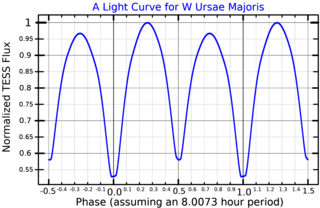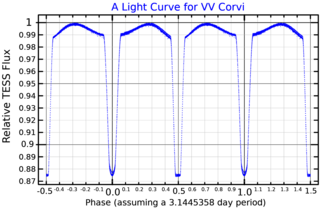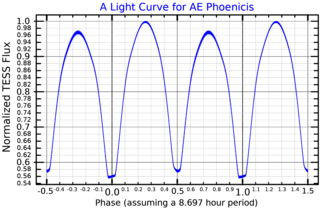
Corvus is a small constellation in the Southern Celestial Hemisphere. Its name means "crow" in Latin. One of the 48 constellations listed by the 2nd-century astronomer Ptolemy, it depicts a raven, a bird associated with stories about the god Apollo, perched on the back of Hydra the water snake. The four brightest stars, Gamma, Delta, Epsilon, and Beta Corvi, form a distinctive quadrilateral or cross-shape in the night sky.

W Ursae Majoris is the variable star designation for a binary star system in the northern constellation of Ursa Major. It has an apparent visual magnitude of about 7.9, which is too faint to be seen with the naked eye. However, it can be viewed with a small telescope. Parallax measurements place it at a distance of roughly 169 light years (52 parsecs) from Earth.

Sigma Aquilae, Latinized from σ Aquilae, is the Bayer designation for a binary star system in the equatorial constellation of Aquila. The baseline apparent magnitude of the pair is +5.17, which, according to the Bortle Dark-Sky Scale, is bright enough to be seen with the naked eye from suburban skies. Because of the Earth's orbit about the Sun, this system has an annual parallax shift of 4.18 mas. This provides a distance estimate of approximately 780 light-years.

S Antliae is a W Ursae Majoris-type eclipsing binary star in Antlia.

LY Aurigae is a multiple star system in the constellation Auriga. It is an eclipsing binary variable star, dropping in brightness by 0.7 magnitudes every 4 days. The system is around a thousand light years away in the Auriga OB1 stellar association.

VV Corvi is a close spectroscopic binary in the constellation Corvus. It is also an eclipsing binary, varying from magnitude 5.19 to 5.34 over 3.145 days. The two stars orbit each other with a period of 1.46 days and an eccentricity of 0.088. The mass ratio of the two stars is 0.775±0.024. The primary is 1.978 ± 0.010 times as massive as the Sun, 18.253 ± 2.249 its luminosity and has 3.375 ± 0.010 the Sun's radius. The secondary is 1.513 ± 0.008 times as massive as the Sun, 4.745 ± 0.583 its luminosity and has 1.650 ± 0.008 the Sun's radius. Both are yellow-white main sequence stars of spectral type F5V, though the primary has begun expanding and cooling as it nears the end of its time on the main sequence. A tertiary companion was discovered during the Two Micron All-Sky Survey.

Epsilon Coronae Australis, is a star system located in the constellation Corona Australis. Varying in brightness between apparent magnitudes of 4.74 to 5 over 14 hours, it is the brightest W Ursae Majoris variable in the night sky.

b Persei is a spectroscopic triple star in the constellation Perseus. Its apparent magnitude is 4.60, and it is about 320 light years away.

Gamma Phoenicis is a star system in the constellation Phoenix, located around 71.63 parsecs (233.6 ly) distant.

V1191 Cygni is the variable star designation for an overcontact binary star system in the constellation Cygnus. First found to be variable in 1965, it is a W Ursae Majoris variable with a maximum apparent magnitude 10.82. It drops by 0.33 magnitudes during primary eclipses with a period of 0.3134 days, while dropping by 0.29 magnitudes during secondary eclipses. The primary star, which is also the cooler star, appears to have a spectral type of F6V, while the secondary is slightly cooler with a spectral type of G5V. With a mass of 1.29 solar masses and a luminosity of 2.71 solar luminosities, it is slightly more massive and luminous than the sun, while the secondary is only around 1/10 as massive and less than half as luminous. With a separation of 2.20 solar radii, the mass transfer of about 2×10−7 solar masses per year from the secondary to the primary is one of the highest known for a system of its type.

RR Centauri is a variable star of apparent magnitude maximum +7.29. It is located in the constellation of Centaurus, approximately 320 light years distant from the solar system.

SV Centauri is a variable star in the constellation Centaurus. An eclipsing binary, its visual apparent magnitude has a maximum of 8.71, fading to 9.98 during primary eclipse and 9.42 during secondary eclipse. From its brightness, it's estimated to be around 6,000 light-years away from Earth. Parallax measurements from Gaia Data Release 2 yield a similar distance of around 2,100 pc.
64 Piscium is the Flamsteed designation for a close binary star system in the zodiac constellation of Pisces. It can be viewed with the naked eye, with the components having a combined apparent visual magnitude of 5.07. An annual parallax shift of 42.64 mas provides a distance estimate of 46.5 light years. The system is moving further from the Sun with a radial velocity of +3.76 km/s.

AB Andromedae is a binary star in the constellation Andromeda. Paul Guthnick and Richard Prager discovered that the star is an eclipsing binary in 1927. Its maximum apparent visual magnitude is 9.49 but shows a variation in brightness down to a magnitude of 10.46 in a periodic cycle of roughly 8 hours. The observed variability is typical of W Ursae Majoris variable stars, so the two stars in this system form a contact binary.

AD Phoenicis is a variable star in the constellation of Phoenix. An eclipsing binary, its apparent magnitude has a maximum of 10.27, dimming to 10.80 during primary and secondary eclipses, which are approximately equal. From parallax measurements by the Gaia spacecraft, the system is located at a distance of 655 light-years from Earth.

AE Phoenicis is a variable star in the constellation of Phoenix. An eclipsing binary, its apparent magnitude has a maximum of 7.56, dimming to 8.25 during primary eclipse and 8.19 during secondary eclipse. From parallax measurements by the Gaia spacecraft, the system is located at a distance of 168 light-years from Earth.

V752 Centauri is multiple star system and variable star in the constellation of Centaurus. An eclipsing binary, its apparent magnitude has a maximum of 9.10, dimming to 9.66 during primary eclipse and 9.61 during secondary eclipse. Its variability was discovered by Howard Bond in 1970. From parallax measurements by the Gaia spacecraft, the system is located at a distance of 410 light-years from Earth.

TX Ursae Majoris is an eclipsing binary star system in the northern circumpolar constellation of Ursa Major. With a combined apparent visual magnitude of 6.97, the system is too faint to be readily viewed with the naked eye. The pair orbit each other with a period of 3.063 days in a circular orbit, with their orbital plane aligned close to the line of sight from the Earth. During the primary eclipse, the net brightness decreases by 1.74 magnitudes, while the secondary eclipse results in a drop of just 0.07 magnitude. TX UMa is located at a distance of approximately 780 light years from the Sun based on parallax measurements, but is drifting closer with a mean radial velocity of −13 km/s.

AG Virginis is an eclipsing binary star system in the equatorial constellation of Virgo. With a maximum apparent visual magnitude of 8.51 it is too faint to be visible to the naked eye. The system is located at a distance of approximately 820 light years from the Sun based on parallax measurements.

AW Ursae Majoris is a binary star system in the northern circumpolar constellation of Ursa Major, abbreviated AW UMa. It is an A-type W Ursae Majoris variable with an apparent visual magnitude of 6.83, which is near the lower limit of visibility to the naked eye. This is an eclipsing binary with the brightness dropping to magnitude 7.13 during the primary eclipse and to 7.08 with the secondary eclipse. Parallax measurements give a distance estimate of 221 light years from the Sun. It is drifting closer to the Sun with a radial velocity of approximately −17 km/s. The system has a high proper motion, traversing the celestial sphere at the rate of 0.216 arc second per annum.



















